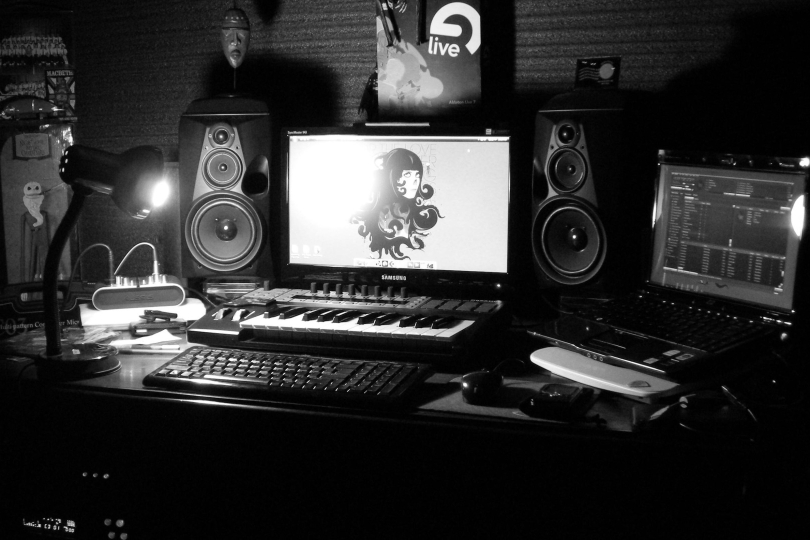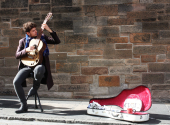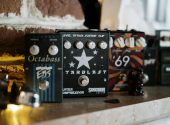
The Guitarist's Survival Guide: Home Studio Essentials
Life as a musician is a mix of performing live and creating magic in the studio. While going to a professional studio with your band is an essential (and fun!) experience as well as a milestone for any serious musician, home recording gear has come a long way, making it easier (and cheaper) than ever to produce high-quality tracks from home. With a few essentials, you’ll be ready to start recording your masterpiece without breaking the bank! Let’s dive in!
1. Audio Interface – The heart of your studio
The heart of your home studio setup is your audio interface (sometimes called an external sound card). This is where your analogue audio signal gets converted to digital, so it can be recorded on your computer. There are dozens of options, from budget compact units to larger devices with multiple inputs. Two inputs (jack/XLR) are common for home studio units. A benefit of these smaller devices is how portable they have become, so you can even record on the go!
I recommend: Focusrite Scarlett Solo
Small, affordable, reliable and easy to use. This has become the standard interface for home studios for good reason.
2. Digital Audio Workstation (DAW) – The Brain of the Operation
Your DAW is where it all comes together: recording, editing, mixing and sometimes even live performance. There’s no shortage of options – Logic Pro, Studio One, Ableton Live, Cubase and Pro Tools, to name a few. They all have pros and cons; for example, Ableton Live is geared more towards electronic music, while Pro Tools is currently the professional studio standard. However, at their core, they all essentially do the same thing, so don’t get too hung up on the gear. The best DAW is the one that fits your needs and that you know well. This is where you'll spend the majority of your recording time, so choose something intuitive and user-friendly.
I recommend: Studio One
I’ve tried several DAWs, but Studio One stands out for me. It offers various options, from a free version to higher-end versions packed with features. I find it intuitive, feature-rich and easy to use – ideal for diving into your music.
3. Cables – Don’t Overlook These
It’s tempting to skimp here, but low-quality cables can introduce noise or degrade your signal. Invest in cables with sturdy connectors and good shielding to keep your sound clean. Also, make sure they’re long enough to avoid frustrating tangles while you record.
I recommend: There are no big secrets here. Any cable that’s not too thin or cheap will probably do the job.
4. Studio Monitors or Headphones – Hearing It Right
Accurate monitoring is essential. The core of what’s important here is that you want a flat response, as opposed to a coloured one. For example, headphones like Beats by Dre may be great for listening to certain types of music, but they artificially increase the bass response, so they’re not accurate for hearing what you're actually recording.
Monitors are ideal for those who want to feel the sound in the room, while quality headphones work well if you're in a smaller space. Either way, these will help you pick up on nuances like string noise and pick attack. Another consideration is that if your room is not treated (meaning sound absorption material to deaden the buildup of certain frequencies in the room) what you're hearing on your monitors may not be accurate. For these reasons, when you’re starting out, it may be best to invest in a decent pair of studio headphones.
I recommend: Sony MDR-7506
Industry-standard, reliable, quality studio headphones.
Yamaha HS5: Small, accurate, and reliable.
5. Microphones – For those with ears to hear
Microphones are obviously a key component of any home studio, but I’d advise against remortgaging your house in an attempt to purchase rare and expensive microphones. I’ll recommend some to you for different applications but don’t stress. Bon Iver’s genre-defining first album was famously recorded with just one microphone – the Shure SM57.
Dynamic mics – As mentioned, the Shure SM57 is an industry standard, great for instruments or guitar amps. Its sister, the SM58, has long been used for live vocals and is nearly indestructible.
Condenser mics – A microphone that requires 48v phantom power (this option is available on most interfaces). It will record in very high detail. Perfect for delicate instruments like acoustic guitar.
I recommend that you do not record your acoustic guitar with a cable and a standard piezo pickup, as it’s generally considered an inferior sound (it works for live performance, but for recording – use a microphone).
6. Splitters – When You Need More Outputs
If you’re recording with a friend and want the option to listen back together, a splitter may be useful. A more expensive option is a headphone amplifier, which can have multiple headphone options, but only get what you need.
A headphone splitter and headphone amplifier
7. Plugins – Effects at Your Fingertips
Virtual effects and plugins let you shape your tone, adding everything from reverb to EQ. Many DAWs come with basic plugins, but you always have the option of investing in some third-party options to expand your creative toolkit. These can emulate classic pedals, amps, and even entire rigs, giving you pro-level sounds without hauling a mountain of gear.
I do suggest to you that it’s more important to become familiar with how the basics work (e.g. EQ, compression) rather than spending a small fortune on third-party plugins. I have friends who have mixed entire professional-quality albums with stock plugins.
8. A Reliable Computer – Keep It Running Smoothly
Last but absolutely not least, your computer should have enough processing power to run your DAW smoothly. It doesn’t need to be the latest model, but ensure it meets the minimum requirements for your chosen software. Regular maintenance and freeing up storage will help prevent those infuriating mid-recording crashes.
Ready to Start Tracking?
Building a home studio takes time and experimentation, and you may not get a mix right the first time, but do remember we do this because it’s fun! It’s never been as easy to get a great mix out of your home studio as it is now, and some artists like Mac Demarco are on record as preferring the vibe and freedom they get in their home studios to working in professional ones!
So grab your gear, get comfortable and start recording. Who knows? Your next big track might be just a few takes away.
If you have found an error or typo in the article, please let us know by e-mail info@insounder.org.




